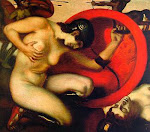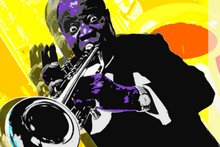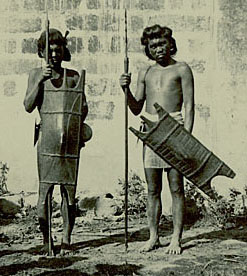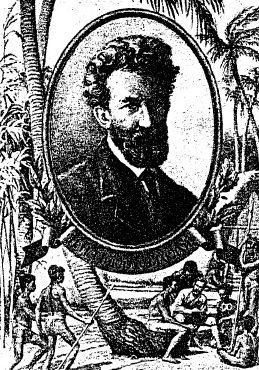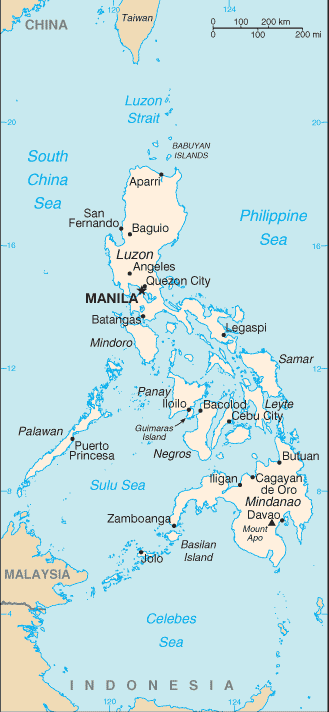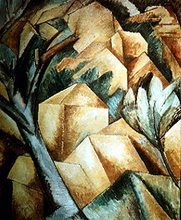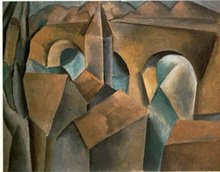The UN estimates the world’s Indigenous population represented in over 70 countries, to be between 300 and 350 million or approximately 5 percent of the total world population. The interests of states in relation to land and natural resources are often at odds with Indigenous peoples’ wishes. The issue places at theorists’ disposal an important theme to discussion: Can self-governing sovereign nations coexist with a sovereign state and not threaten the dismemberment of the existing state?
The 1993 negotiation between four Indian nations and the United States of America set a standard for future bilateral government-to-government relations between nations and states. Basing on that empirical example R. Ryser (1995) claims that although the Jamestown S'Klallam, Hoopa, Lummi and Quinault are not strategically important nations in any geopolitical sense, their success will point the way to peaceful resolution of conflicts between states and the nations inside their boundaries around the world.There are however some obstacles to assured constructive and positive outcome to government-to-government relations between nations and states. One of them is in the fact that among Indigenous peoples the foraging peoples dominated much of the world until recently (R. Blench 1999). Foragers, by the nature of their society, will not easily form articulate advocacy groups without external assistance. However, without such groups, their rights will be eroded rapidly in many places. For example, even numbers of hunter-gatherers worldwide are extremely difficult to estimate because many national governments such as those of India and Malaysia regard foragers as indicators of backwardness and forbid research relating to them.
I believe and empirical examples of the Quinault, Lummi, Jamestown S'Klallam and Hoopa negotiation with the United States of America as well as the establishment in 1999 of Nunavut, a self-governing territory for the Inuit people of north-west Canada, confirm my stance that the self-governing sovereign nations and sovereign states coexistence is a nearest future of international relationships in the world.
Ryser, Rudolph C., 1995. Resuming Self-Government in Indian Country: From Imposed Government to Self-Rule Inside and Outside the United States of America. Center for World Indigenous Studies. Ed. by Murdoch: University School of Law, Canning Vale, Western Australia. March.
Blench, Roger, 1999. Hunter-Gatherers, Conservation and Development: From Prejudice to Policy reform. Overseas Development Institute. # 43, June. London.
Tuesday, December 18, 2007
Monday, December 17, 2007
Philippine Civil Society Institutions in Taiwan
Abstract
Globalization causes more and more people leave their native countries to seek work abroad. The people of weaker nations become cheap labor. Due to the lack of protections, companies from powerful industrialized nations are able to force workers to endure extremely long hours, unsafe working conditions, and just enough salary to keep them working. Another important issue is that nowadays more and more representatives of indigenous peoples also leave their native places to work abroad. It causes the loss of the cultural heritage of indigenous peoples.
Can the Diasporas’ civil society institutions achieve their purposes such as to defend overseas workers and indigenous peoples’ human and cultural rights on the territory of foreign state? In my work I focus on Philippine civil society institutions in Taiwan. I study the subject on examples of two organizations. Both organizations play role of trade unions and have a purpose to defend overseas Filipino workers rights. One among them - the Cordillera Organization in Taiwan – besides that is an indigenous peoples’ organization, which try to defend human and cultural rights of Philippine Igorot ethnic group.
In this work I show that on the territory of foreign state the Diasporas’ civil society institutions can successfully achieve their goals only in cooperation with local NGOs.
Igor Sitnikov
Globalization causes more and more people leave their native countries to seek work abroad. The people of weaker nations become cheap labor. Due to the lack of protections, companies from powerful industrialized nations are able to force workers to endure extremely long hours, unsafe working conditions, and just enough salary to keep them working. Another important issue is that nowadays more and more representatives of indigenous peoples also leave their native places to work abroad. It causes the loss of the cultural heritage of indigenous peoples.
Can the Diasporas’ civil society institutions achieve their purposes such as to defend overseas workers and indigenous peoples’ human and cultural rights on the territory of foreign state? In my work I focus on Philippine civil society institutions in Taiwan. I study the subject on examples of two organizations. Both organizations play role of trade unions and have a purpose to defend overseas Filipino workers rights. One among them - the Cordillera Organization in Taiwan – besides that is an indigenous peoples’ organization, which try to defend human and cultural rights of Philippine Igorot ethnic group.
In this work I show that on the territory of foreign state the Diasporas’ civil society institutions can successfully achieve their goals only in cooperation with local NGOs.
Igor Sitnikov
Friday, October 12, 2007
James George Frazer
James George Frazer (1854 – 1941), was a Scottish social anthropologist influential in the early stages of the modern studies of mythology and comparative religion. Except for Italy and Greece, Frazer was not widely traveled. His prime sources of data were ancient histories and questionnaires mailed to missionaries and Imperial officials all over the globe. Frazer's interest in social anthropology was aroused by reading E.B. Tylor’s Primitive Culture (1871) and encouraged by his friend, the biblical scholar William Robertson Smith, who was linking the Old Testament with early Hebrew folklore.
He was the first to detail the relations between myth and rituals. His theories of totemism were superseded by Claude Levi-Strauss. The Golden Bough, his study of ancient cults, rites, and myths, including their parallels with early Christianity, arguably his greatest work, is still rifled by modern mythographers for its detailed information.
While James Frazer is best known for his tripartite division of all culture into the stages of magic, religion, and science, the bulk of his tome is devoted to an intermediate stage between religion and science – a stage of magic and religion combined. In this in between stage is to be found myth-ritualism, for only here do myths and rituals work together. In the stage of sheer magic there are rituals – the routines involved in carrying out the directions – but no myths, for there are no gods. In the stage of religion there are both myths and rituals, but they are barely connected. Myths describe the character and behavior of gods. Rituals seek to curry divine favor. Rituals may presuppose myths, which suggest what activities would most please the gods, but they are otherwise independent of myths. (R.A. Segal. 1998, 3)
the character and behavior of gods. Rituals seek to curry divine favor. Rituals may presuppose myths, which suggest what activities would most please the gods, but they are otherwise independent of myths. (R.A. Segal. 1998, 3)
“Frazer presents two distinct versions of myth-ritualism.
In the first version myth describes the life of the god of vegetation, and ritual enacts the myth, or at least that portion of the myth describing the death and rebirth of the god. The ritual operates on the basis of the Law of Similarity, according to which the imitation of an action causes it to happen. … The assumption that vegetation is under the control of a god is the legacy of religion. The assumption that vegetation can be controlled, even if only through the king, is the legacy of magic. … In the ritual a human being plays the role of the god and acts out what he magically causes the god to do.” (R.A. Segal. 1998, 4)
“In Frazer’s second version of myth-ritualism the king is central. …King is himself divine, by which Frazer means that the god resides him. Just as the health of vegetation depends on the health of its god, so now the health of the god depends on the health of the king… To ensure a steady supply of food, the community kills its king while he is still in his prime and thereby safely transfers the soul of the god to his successor. … The king is killed either at the end of a fixed term or at the first sign of infirmity.” (R.A. Segal. 1998, 4) In this second version of myth-ritualism instead of enacting the myth of the god of vegetation, the ritual simply changes the residence of the god. “The king dies not in imitation of the death of the god but as a sacrifice to preserve the health of the god. … Instead of reviving the god by magical imitation, the ritual revives the god by a transplant. It would therefore be better to restrict the term myth-ritualism to Frazer’s first version of the theory.” (R.A. Segal. 1998, 5)
Myth for Frazer, as for Tylor, serves to explain the world… For Tylor myth is the ancient and primitive counterpart to modern science and primarily to scientific theory, but for Frazer it is the counterpart to applied science.
The Myth and Ritual Theory. An Anthology. Edited by Robert A. Segal. 1998. Blackwell Publishers Inc. Malden, Massachusetts, USA.
He was the first to detail the relations between myth and rituals. His theories of totemism were superseded by Claude Levi-Strauss. The Golden Bough, his study of ancient cults, rites, and myths, including their parallels with early Christianity, arguably his greatest work, is still rifled by modern mythographers for its detailed information.
While James Frazer is best known for his tripartite division of all culture into the stages of magic, religion, and science, the bulk of his tome is devoted to an intermediate stage between religion and science – a stage of magic and religion combined. In this in between stage is to be found myth-ritualism, for only here do myths and rituals work together. In the stage of sheer magic there are rituals – the routines involved in carrying out the directions – but no myths, for there are no gods. In the stage of religion there are both myths and rituals, but they are barely connected. Myths describe
 the character and behavior of gods. Rituals seek to curry divine favor. Rituals may presuppose myths, which suggest what activities would most please the gods, but they are otherwise independent of myths. (R.A. Segal. 1998, 3)
the character and behavior of gods. Rituals seek to curry divine favor. Rituals may presuppose myths, which suggest what activities would most please the gods, but they are otherwise independent of myths. (R.A. Segal. 1998, 3)“Frazer presents two distinct versions of myth-ritualism.
In the first version myth describes the life of the god of vegetation, and ritual enacts the myth, or at least that portion of the myth describing the death and rebirth of the god. The ritual operates on the basis of the Law of Similarity, according to which the imitation of an action causes it to happen. … The assumption that vegetation is under the control of a god is the legacy of religion. The assumption that vegetation can be controlled, even if only through the king, is the legacy of magic. … In the ritual a human being plays the role of the god and acts out what he magically causes the god to do.” (R.A. Segal. 1998, 4)
“In Frazer’s second version of myth-ritualism the king is central. …King is himself divine, by which Frazer means that the god resides him. Just as the health of vegetation depends on the health of its god, so now the health of the god depends on the health of the king… To ensure a steady supply of food, the community kills its king while he is still in his prime and thereby safely transfers the soul of the god to his successor. … The king is killed either at the end of a fixed term or at the first sign of infirmity.” (R.A. Segal. 1998, 4) In this second version of myth-ritualism instead of enacting the myth of the god of vegetation, the ritual simply changes the residence of the god. “The king dies not in imitation of the death of the god but as a sacrifice to preserve the health of the god. … Instead of reviving the god by magical imitation, the ritual revives the god by a transplant. It would therefore be better to restrict the term myth-ritualism to Frazer’s first version of the theory.” (R.A. Segal. 1998, 5)
Myth for Frazer, as for Tylor, serves to explain the world… For Tylor myth is the ancient and primitive counterpart to modern science and primarily to scientific theory, but for Frazer it is the counterpart to applied science.
The Myth and Ritual Theory. An Anthology. Edited by Robert A. Segal. 1998. Blackwell Publishers Inc. Malden, Massachusetts, USA.
Samuel Henry Hooke
Samuel Henry Hooke (1874 – 1968) was an English scholar writing on comparative religion. He is known for his translation of the Bible into Basic English. He was Professor of Old Testament Studies in the University of London, edited three collections of essays that sought to establish the existence of a myth-ritualist pattern in the ancient Near East (Mesopotamia, Egypt).
Hooke carries myth-ritualism further than Frazer in conferring on myth the same magical power contained in the ritual. “The spoken word,” says Hooke, “had the efficacy of an act…” (“The Myth and Ritual Pattern of the Ancient East,” p. 3).
Hooke carries myth-ritualism further than Frazer in conferring on myth the same magical power contained in the ritual. “The spoken word,” says Hooke, “had the efficacy of an act…” (“The Myth and Ritual Pattern of the Ancient East,” p. 3).
Jane Ellen Harrison
 Jane Ellen Harrison (1850 – 1928) was a ground-breaking British classical scholar, linguist and feminist. Harrison is one of the founders of modern studies in Greek mythology. She applied 19th century archaeological discoveries to the interpretation of Greek religion in ways that have become standard. Harrison learned: initially German, Latin, Greek and Hebrew, later expanded to about sixteen languages, including Russian.
Jane Ellen Harrison (1850 – 1928) was a ground-breaking British classical scholar, linguist and feminist. Harrison is one of the founders of modern studies in Greek mythology. She applied 19th century archaeological discoveries to the interpretation of Greek religion in ways that have become standard. Harrison learned: initially German, Latin, Greek and Hebrew, later expanded to about sixteen languages, including Russian.Harrison carries myth-ritualism further than Frazer in conferring on myth the same magical power contained in the ritual. “A myth,” says Harrison, “becomes practically a story of magical intent and potency” (Themis, p. 330).
Thursday, October 11, 2007
William Robertson Smith
 William Robertson Smith (1846 – 1894) was a Scottish orientalist, Old Testament scholar, professor of divinity, and minister of the Free Church of Scotland. He is also known for his book Religion of the Semites, which is considered a foundational text in the comparative study of religion. Religion of the Semites is an account of ancient Jewish religious life which pioneered the use of sociology in the analysis of religious phenomenon.
William Robertson Smith (1846 – 1894) was a Scottish orientalist, Old Testament scholar, professor of divinity, and minister of the Free Church of Scotland. He is also known for his book Religion of the Semites, which is considered a foundational text in the comparative study of religion. Religion of the Semites is an account of ancient Jewish religious life which pioneered the use of sociology in the analysis of religious phenomenon.“In a few introductory pages of his Lectures on the Religion of the Semits the Victorian biblicist and Arabist William Robertson Smith pioneered the myth-ritualist theory. … Smith’s approach to ancient religion is behaviorist.” (R.A. Segal. 1998, 1)
“According to Smith, “in almost every case the myth was derived from the ritual and not the ritual from the myth (Smith 1889, 19) … myth is merely the explanation of a religious usage.” (R.A. Segal. 1998, 2)
“The antique religions had for the most part no creed; they consisted entirely of institutions and practices” (Smith 1889, 18). Smith grants that ancients, whom he compares with primitives, doubtless performed rituals for some reason: “No doubt men will not habitually follow certain practices without attaching a meaning to them” (Smith 1889, 18). (R.A. Segal. 1998, 2)
For Smith, ritual is conspicuously more important than myth, which he calls “secondary”. (R.A. Segal. 1998, 3)
1. The Myth and Ritual Theory. An Anthology. Edited by Robert A. Segal. 1998. Blackwell Publishers Inc. Malden, Massachusetts, USA.
2. William Robertson Smith, Lectures on the Religion of the Semits, First Series, 1st edn (Edinburgh: Black, 1889).
Edward Tylor
 Sir Edward Burnett Tylor, an English Anthropologist (1832 - 1917). In 1883, Tylor became the head of the University Museum at Oxford and was a Professor of Anthropology from 1896 until 1909. Published in 1881, Tylor’s first book, Anthropology, is still considered to be modern in its cultural concepts and theories.
Sir Edward Burnett Tylor, an English Anthropologist (1832 - 1917). In 1883, Tylor became the head of the University Museum at Oxford and was a Professor of Anthropology from 1896 until 1909. Published in 1881, Tylor’s first book, Anthropology, is still considered to be modern in its cultural concepts and theories.Tylor was not particularly interested in fieldwork. He derived most of the material for his comparative studies through extensive readings of Classical materials (literature and history of Greece and Rome), the work of the early European folklorists, and reports from missionaries, travelers, and contemporaneous ethnologists.
Tylor is considered representative of cultural evolutionism, based on the evolutionary theories of Charles Darwin. Tylor generally seemed to assume a Victorian idea of progress rather than the idea of non-directional, multilineal cultural development proposed by later anthropologists. He believed that there was a functional basis for the development of society and religion, which he determined was universal. He reintroduced the term animism (the faith in the individual soul or anima of all things) into common use. He considered animism as the first phase of development of religions.
Tylor formulated one of the early and influential anthropological conceptions of culture as "that complex whole which includes knowledge, belief, art, morals, law, custom, and any other capabilities and habits acquired by man as a member of society."
He formulated also the classical conception of myth as an explanation of the world.
“For Tylor, myth is an account of events in the physical world. Myth is more important than ritual, which is the application, not the subject, of myth. Myth constitutes creed, which is merely expressed in the form of a story. For Tylor, myth serves the same function as science. Indeed, myth is the ancient and primitive counterpart to modern science.” (Robert A. Segal. 1998. Introduction to the The Myth and Ritual Theory, an anthology, edited by Robert A. Segal.)
http://en.wikipedia.org/wiki/Edward_Burnett_Tylor
http://en.wikipedia.org/wiki/Anthropology
Tuesday, September 4, 2007
Igor meets Igorots

Pagan ritual in the center of Taipei city
About two weeks ago I was so lucky to participate in the pagan ritual in the center of modern Taipei city. My recently research of Negritos and their former existence in Taiwan evidence brought me to the studying of Philippines ethnology.
According to many researches the Pygmies (or “Negritos” which, in Enlish, means “little black people”) came to the Philippines from the south by landward migrations across the land bridges about 25,000 to 30,000 years ago. They became the aboriginal inhabitants of the Philippines, and their descendants, still exist there.
Later from the mainland of Southeasten Asia the first seafaring immigrants - the Indonesians (which means “Island Indians”) - came in rough-hewn sailboats to the Philippines shores. They came in two main waves of migration, the first wave dating about 5,000 years ago and the second wave about 3,500 years ago. It is said that they belonged to the Mongolian race but with Caucasic affinities.
The Indonesians fought with the Negritoes for ownership of the land. Possessing a higher type of culture and armed with better weapons, the Indonesians triumphed over their Negrito opponents. The Indonesians with whom the Negritoes afterwards intermingled in various degrees drove the “little black people” to the interior regions.
According to D.P Barrows (D.P. Barrows. p. 5) “the Negritos have retired from many places where they lived when the Spaniards first arrived”, but by the beginning of 20th century there were still “several thousand in Luzon, especially in the Cordillera Zambales, and in the Sierra Madre range on the Pacific coast, and in the interior of Panay and Negros, and in Surigao of Mindanao.” Now the Negritoes, popularly known in Philippines as the Agta or the Aeta, live in the mountainous areas of Luzon, Negros, Panay, and Mindanao.
The last Asian immigrants to colonize the Philippines during prehistoric times were the brown-skinned, maritime Malays. The Indonesians were in tern driven by the Malays from the coastlands and open plains.
Gregorio F. Zaide cites (G. F. Zaide. 1957, 24-25) Professor Blumentritt, who says, “The ancient Malays reached the Philippines in three main migratory waves. The first wave arrived at about 200 B.C., representing the headhunting Malays – the ancestors of the Bontoks, Ifugaos, and Tinggians of Northern Luzon. The second wave came after the start of the Christian era, from 100 A.D. to the 13th century A.D., representing the alphabet-using Malays – the ancestors of the Bisayans, Tagalogs, Ilokanos, Bikols, Pampangans, and other Christian Filipinos. And the third wave arrived between the 14th and the 16th century A.D., representing the Mohammedan Malays – the ancestors of the present-day Moros.”
The people, whom I so luckily and surprisingly met in the park near Minquan W. Rd. MRT station in Taipei City called themselves Igorots and were the descendants of the ancient headhunting Malays of Philippines.
Igorot is the general name for the people of the Cordillera region, in the island of Luzon. Some Igorot groups formerly practiced headhunting. The Igorots are grouped into six ethno-linguistic groups, the Bontoc, Ibaloi, Ifugao, Isneg (or Apayao), Kalinga, and the Kankana-ey.
The Bontocs, who live on the banks of the Chico River, were once well-known because of their headhunting practices. From ancient times they did perform a circular rhythmic dance acting out certain aspects of the hunt, always accompanied by the bronze gong. There was no singing or talking during the dance drama. It was a serious but plesurable event for all concerned, including the children. In the center of the modern Taipei I did take part in such kind of the dance drama with the Bontocs, who work in Taiwan and have cultural and religious ceremonies in the night park almost every Sunday. It was amazing! one of the participants even gave me a bronze gong to try utter the sound.
Historically a hereditary class of priests hold various monthly ceremonies. I was lucky to talk with one of them, about 35-years old intellectual, who studies in Hualian the culture of Amis tribe.
Nowadays many Igorots as other Filipinos have left their mountain homes to seek better opportunities all over the world. Like many Diasporas, they maintain their cultural heritage in foreign lands by gathering together in common bond. In the night park by a lucky chance I met the members of the Igorots Diaspora organization which purpose is to keep their traditions alive.
1. David P. Barrows. 1926. History of the Philippines. New York. Copyright 1905 by David P. Barrows.
D.P Barrows was the Professor of Political Science, University of California;Formerly City Superintendent of Schools, Manila, 1900-01;Chief of the Bureau of Non-Christian Tribes of the Philippines, 1901-03;Director of Education for the Philippines, 1903-09;Formerly President of the University of California.
2. Gregorio F. Zaide. 1957. Philippine Political and Cultural History. Vol. I. The Philippines Since Pre-Spanish Times. Manila: Philippine Education Company.
About two weeks ago I was so lucky to participate in the pagan ritual in the center of modern Taipei city. My recently research of Negritos and their former existence in Taiwan evidence brought me to the studying of Philippines ethnology.
According to many researches the Pygmies (or “Negritos” which, in Enlish, means “little black people”) came to the Philippines from the south by landward migrations across the land bridges about 25,000 to 30,000 years ago. They became the aboriginal inhabitants of the Philippines, and their descendants, still exist there.
Later from the mainland of Southeasten Asia the first seafaring immigrants - the Indonesians (which means “Island Indians”) - came in rough-hewn sailboats to the Philippines shores. They came in two main waves of migration, the first wave dating about 5,000 years ago and the second wave about 3,500 years ago. It is said that they belonged to the Mongolian race but with Caucasic affinities.
The Indonesians fought with the Negritoes for ownership of the land. Possessing a higher type of culture and armed with better weapons, the Indonesians triumphed over their Negrito opponents. The Indonesians with whom the Negritoes afterwards intermingled in various degrees drove the “little black people” to the interior regions.
According to D.P Barrows (D.P. Barrows. p. 5) “the Negritos have retired from many places where they lived when the Spaniards first arrived”, but by the beginning of 20th century there were still “several thousand in Luzon, especially in the Cordillera Zambales, and in the Sierra Madre range on the Pacific coast, and in the interior of Panay and Negros, and in Surigao of Mindanao.” Now the Negritoes, popularly known in Philippines as the Agta or the Aeta, live in the mountainous areas of Luzon, Negros, Panay, and Mindanao.
The last Asian immigrants to colonize the Philippines during prehistoric times were the brown-skinned, maritime Malays. The Indonesians were in tern driven by the Malays from the coastlands and open plains.
Gregorio F. Zaide cites (G. F. Zaide. 1957, 24-25) Professor Blumentritt, who says, “The ancient Malays reached the Philippines in three main migratory waves. The first wave arrived at about 200 B.C., representing the headhunting Malays – the ancestors of the Bontoks, Ifugaos, and Tinggians of Northern Luzon. The second wave came after the start of the Christian era, from 100 A.D. to the 13th century A.D., representing the alphabet-using Malays – the ancestors of the Bisayans, Tagalogs, Ilokanos, Bikols, Pampangans, and other Christian Filipinos. And the third wave arrived between the 14th and the 16th century A.D., representing the Mohammedan Malays – the ancestors of the present-day Moros.”
The people, whom I so luckily and surprisingly met in the park near Minquan W. Rd. MRT station in Taipei City called themselves Igorots and were the descendants of the ancient headhunting Malays of Philippines.
Igorot is the general name for the people of the Cordillera region, in the island of Luzon. Some Igorot groups formerly practiced headhunting. The Igorots are grouped into six ethno-linguistic groups, the Bontoc, Ibaloi, Ifugao, Isneg (or Apayao), Kalinga, and the Kankana-ey.
The Bontocs, who live on the banks of the Chico River, were once well-known because of their headhunting practices. From ancient times they did perform a circular rhythmic dance acting out certain aspects of the hunt, always accompanied by the bronze gong. There was no singing or talking during the dance drama. It was a serious but plesurable event for all concerned, including the children. In the center of the modern Taipei I did take part in such kind of the dance drama with the Bontocs, who work in Taiwan and have cultural and religious ceremonies in the night park almost every Sunday. It was amazing! one of the participants even gave me a bronze gong to try utter the sound.
Historically a hereditary class of priests hold various monthly ceremonies. I was lucky to talk with one of them, about 35-years old intellectual, who studies in Hualian the culture of Amis tribe.
Nowadays many Igorots as other Filipinos have left their mountain homes to seek better opportunities all over the world. Like many Diasporas, they maintain their cultural heritage in foreign lands by gathering together in common bond. In the night park by a lucky chance I met the members of the Igorots Diaspora organization which purpose is to keep their traditions alive.
1. David P. Barrows. 1926. History of the Philippines. New York. Copyright 1905 by David P. Barrows.
D.P Barrows was the Professor of Political Science, University of California;Formerly City Superintendent of Schools, Manila, 1900-01;Chief of the Bureau of Non-Christian Tribes of the Philippines, 1901-03;Director of Education for the Philippines, 1903-09;Formerly President of the University of California.
2. Gregorio F. Zaide. 1957. Philippine Political and Cultural History. Vol. I. The Philippines Since Pre-Spanish Times. Manila: Philippine Education Company.
Sunday, July 8, 2007
Kazimir Malevich says

Malevich wrote about Suprematism in his treatise The Non-Objective World: Suprematism is the rediscovery of pure art that, in the course of time, had become obscured by the accumulation of "things" . . . The black square on the white field was the first form in which nonobjective feeling came to be expressed. The square = feeling, the white field = the void beyond this feeling. Yet the general public saw in the nonobjectivity of the representation the demise of art and failed to grasp the evident fact that feeling had here assumed external form. The Suprematist square and the forms proceeding out of it can be likened to the primitive marks (symbols) of aboriginal man, which represented, in their combination, not ornament, but a feeling of rhythm. Suprematism did not bring into being a new world of feeling but, rather, an altogether new and direct form of representation of the world of feeling . . .. The new art of Suprematism, which has produced new forms and form relationships by giving external expression to pictorial feeling, will become a new architecture: it will transfer these forms from the surface of canvas to space . . .. Suprematism has opened up new possibilities to creative art, since by virtue of the abandonment of so-called "practical consideration, " a plastic feeling rendered on canvas can be carried over into space. The artist (the painter) is no longer bound to the canvas (the picture plane) and can transfer his compositions from canvas to space"
Saturday, July 7, 2007
Suprematism is a Desert

Kazimir Malevich says:
Under Suprematism I understand the supremacy of pure feeling in creative art. To the Suprematist the visual phenomena of the objective world are, in themselves, meaningless; the significant thing is feeling, as such…
Feeling is the determining factor ... and thus art arrives at non objective representation at Suprematism.
It reaches a "desert" in which nothing can be perceived but feeling.
But this desert is filled with the spirit of nonobjective sensation which pervades everything. …A blissful sense of liberating nonobjectivity drew me forth into the "desert," where nothing is real except feeling . . . and so feeling became the substance of my life.
We have seen how art, at the turn of the century, divested itself of the ballast of religious and political ideas which had been imposed upon it and came into its own attained, that is, the form suited to its intrinsic nature and became, along with the two already mentioned, a third independent and equally valid point of view.
Art no longer cares to serve the state and religion, it no longer wishes to illustrate the history of manners, it wants to have nothing further to do with the object, as such, and believes that it can exist, in and for itself, without "things"…
Suprematism has opened up new possibilities to creative art.., a plastic feeling rendered on canvas can be carried over into space. The artist (the painter) is no longer bound to the canvas (the picture plane) and can transfer his compositions from canvas to space.
http://www.artchive.com/artchive/M/malevich.html
Thursday, July 5, 2007
Cubism
10 July, Tuesday Painting Class Agenda
Analytic cubism
Cubism was a short but highly significant art movement between about 1907 and 1914 in France. The most notable of cubism's participants were Pablo Picasso and Georges Braque. In cubist artworks, objects are broken up, analyzed, and re-assembled in an abstracted form — instead of depicting objects from one viewpoint, the artist depicts the subject from a multitude of viewpoints to represent the subject in a greater context. The roots of cubism are to be found in the Paul Cezanne’s later works:
1. The idea to break the painted surface into small multifaceted areas of paint;
2. The simplification of natural forms into cylinders, spheres, pyramids and cubes.
2 Main Types of Cubism
There are two main types of cubism, analytical cubism and synthetic cubism. Analytic cubism was mainly practiced by Braque, and is very simple, with dark, almost monochromatic colours. Synthetic cubism was much more energetic, and often made use of collage including the use of several two-dimensional materials. This type of cubism was developed by Picasso.
Analytic cubism is the first form of cubism. The time period was from about 1907-1912. Color was almost a monochromatic scheme that often included grey, blue and ochre. Instead of an emphasis on colour, Analytic cubists had gotten the idea from Paul Cezanne and focused on forms like the cylinder, sphere and the cone to represent the natural world.
Illustrations
Analytic cubism
http://www.roberto-crosio.net/1_citta/BRAQUE_PICASSO.htm
1. The idea to break the painted surface into small multifaceted areas of paint;
2. The simplification of natural forms into cylinders, spheres, pyramids and cubes.
2 Main Types of Cubism
There are two main types of cubism, analytical cubism and synthetic cubism. Analytic cubism was mainly practiced by Braque, and is very simple, with dark, almost monochromatic colours. Synthetic cubism was much more energetic, and often made use of collage including the use of several two-dimensional materials. This type of cubism was developed by Picasso.
Analytic cubism is the first form of cubism. The time period was from about 1907-1912. Color was almost a monochromatic scheme that often included grey, blue and ochre. Instead of an emphasis on colour, Analytic cubists had gotten the idea from Paul Cezanne and focused on forms like the cylinder, sphere and the cone to represent the natural world.
Illustrations
Analytic cubism
http://www.roberto-crosio.net/1_citta/BRAQUE_PICASSO.htm
Saturday, June 9, 2007
A still life based on a complementary colors color scheme
10 June, Sunday Painting Class Agenda
Color harmony
Color harmony creates an inner sense of order, a balance in the visual experience.
When something is not harmonious, it's either boring or chaotic. At one extreme is a visual experience that is so bland that the viewer is not engaged. The human brain will reject under-stimulating information. At the other extreme is a visual experience that is so overdone, so chaotic that the viewer can't stand to look at it. The human brain rejects what it can not organize. The visual task requires that we present a logical structure. Color harmony delivers visual interest and a sense of order. In summary, extreme unity leads to under-stimulation, extreme complexity leads to over-stimulation. Harmony is a dynamic equilibrium.
A color scheme based on analogous colors
Analogous colors are any three colors which are side by side on a 12 part color wheel, such as yellow-green, yellow, and yellow-orange. Usually one of the three colors predominates.
A color scheme based on complementary colors
Complementary colors are any two colors, which are directly opposite each other, such as red and green and red-purple and yellow-green. These opposing colors create maximum contrast and maximum stability.
A color circle or wheel
A color circle, based on red, yellow and blue, is traditional in the field of art. Sir Isaac Newton developed the first circular diagram of colors in 1666. Since then scientists and artists have studied and designed numerous variations of this concept.
PRIMARY COLORS: red, yellow and blue
In traditional color theory, these are the 3 pigment colors that cannot be mixed or formed by any combination of other colors. All other colors are derived from these 3 hues.
SECONDARY COLORS: Green, orange and purple
These are the colors formed by mixing the primary colors.
TERTIARY COLORS: yellow-orange, red-orange, red-purple, blue-purple, blue-green and yellow-green
These are the colors formed by mixing a primary and a secondary color. That's why the hue is a two-word name, such as blue-green, red-violet, and yellow-orange.
http://www.colormatters.com/colortheory.html
http://www.behr.com/behrx/inspiration/artistic_1.jsp
http://www.ecoverdesigns.com/articles/colorwheel.htm
Color harmony
Color harmony creates an inner sense of order, a balance in the visual experience.
When something is not harmonious, it's either boring or chaotic. At one extreme is a visual experience that is so bland that the viewer is not engaged. The human brain will reject under-stimulating information. At the other extreme is a visual experience that is so overdone, so chaotic that the viewer can't stand to look at it. The human brain rejects what it can not organize. The visual task requires that we present a logical structure. Color harmony delivers visual interest and a sense of order. In summary, extreme unity leads to under-stimulation, extreme complexity leads to over-stimulation. Harmony is a dynamic equilibrium.
A color scheme based on analogous colors
Analogous colors are any three colors which are side by side on a 12 part color wheel, such as yellow-green, yellow, and yellow-orange. Usually one of the three colors predominates.
A color scheme based on complementary colors
Complementary colors are any two colors, which are directly opposite each other, such as red and green and red-purple and yellow-green. These opposing colors create maximum contrast and maximum stability.
A color circle or wheel
A color circle, based on red, yellow and blue, is traditional in the field of art. Sir Isaac Newton developed the first circular diagram of colors in 1666. Since then scientists and artists have studied and designed numerous variations of this concept.
PRIMARY COLORS: red, yellow and blue
In traditional color theory, these are the 3 pigment colors that cannot be mixed or formed by any combination of other colors. All other colors are derived from these 3 hues.
SECONDARY COLORS: Green, orange and purple
These are the colors formed by mixing the primary colors.
TERTIARY COLORS: yellow-orange, red-orange, red-purple, blue-purple, blue-green and yellow-green
These are the colors formed by mixing a primary and a secondary color. That's why the hue is a two-word name, such as blue-green, red-violet, and yellow-orange.
http://www.colormatters.com/colortheory.html
http://www.behr.com/behrx/inspiration/artistic_1.jsp
http://www.ecoverdesigns.com/articles/colorwheel.htm
Friday, May 25, 2007
Galaxy SI 19361
From today I plan to introduce here not only my own art, but also some examples of Russian culture. I will introduce only things, which I really like. I hope it will help to visualize my own ideal image of Russian culture. It would be honor for me as an artist to identify myself with this pure ideal, which already exist subconsciously somewhere in the mystical space of my soul.
Wednesday, May 23, 2007
Last Hope
OK. It was a love story. We met and separated. I still loved the girl. And I still loved the music of Led Zeppelin, from 1976. I used to send her messages on her cellular phone to explain my feelings. Sometimes I used the words from Led Zeppelin’s songs for it, because Led Zeppelin is not only music and verses, but it has become the sound of my soul. Formerly she could find the words to answer, and her words sounded like the Plant’s high voice!
When we separated I tried to draw my messages. It was the mystical way in which I could be with her soul for some hours during the work. When I finished a drawing I sent her the verse from it… These drawings were my last hope… There was no answer…
Graphic series
Last Hope
6 sheets-messages
Paper, Indian ink, pen.
27x19 cm
19x27 cm
http://www.flickr.com/photos/7910873@N05/
Message #1
Houses of the Holy
We can watch the white doves go
From the door comes Satan’s daughter
And it only goes to show
Ah, you know
There’s an angel on my shoulder
In my hand a sword of gold
Let me wander in your garden
And the seeds of love I’ll sow
Message #2
No Quarter
The snow falls hard and don’t you know?
The winds of Thor are blowing cold.
They’re wearing steel that’s bright and true
They carry news that must get through, oooh
They choose the path where no-one goes.
They hold no quarter, they hold no quarter.
Walking side by side with death
The devil mocks their every step
The snow drives back the foot that’s slow
The dogs of doom are howling more
Message #3
Kashmir
I am a traveler of both time and space
To be where I have been
T’ sit with elders of the gentle race
This world has seldom seen
Th’ talk of days for which they sit and wait
All will be revealed
Oooh, oh baby, I been flyin’
Message #4
Kashmir
Oh, father of the four winds, fill my sails Across the sea of years
With no provision but an open face ‘Long the straits of fear
Whaoh, whaoh Whaoh-oh, oh Ohhhh
Message #5
AchillesLast Stand
It was an April morning, When they told us we should go
The devil in his hole Hides inside and never seen, yeah
The shackles of commitment fell, In pieces on the ground Oh to ride the wind
Message #6
Ten Years Gone
Then as it was, then again it will be
An’ though the course may change sometimes
Rivers always reach the sea
We are eagles of one nest
The nest is in our soul
Vixen in my dreams, with great surprise to me
Never thought I’d see your face the way it used to be
When we separated I tried to draw my messages. It was the mystical way in which I could be with her soul for some hours during the work. When I finished a drawing I sent her the verse from it… These drawings were my last hope… There was no answer…
Graphic series
Last Hope
6 sheets-messages
Paper, Indian ink, pen.
27x19 cm
19x27 cm
http://www.flickr.com/photos/7910873@N05/
Message #1
Houses of the Holy
We can watch the white doves go
From the door comes Satan’s daughter
And it only goes to show
Ah, you know
There’s an angel on my shoulder
In my hand a sword of gold
Let me wander in your garden
And the seeds of love I’ll sow
Message #2
No Quarter
The snow falls hard and don’t you know?
The winds of Thor are blowing cold.
They’re wearing steel that’s bright and true
They carry news that must get through, oooh
They choose the path where no-one goes.
They hold no quarter, they hold no quarter.
Walking side by side with death
The devil mocks their every step
The snow drives back the foot that’s slow
The dogs of doom are howling more
Message #3
Kashmir
I am a traveler of both time and space
To be where I have been
T’ sit with elders of the gentle race
This world has seldom seen
Th’ talk of days for which they sit and wait
All will be revealed
Oooh, oh baby, I been flyin’
Message #4
Kashmir
Oh, father of the four winds, fill my sails Across the sea of years
With no provision but an open face ‘Long the straits of fear
Whaoh, whaoh Whaoh-oh, oh Ohhhh
Message #5
AchillesLast Stand
It was an April morning, When they told us we should go
The devil in his hole Hides inside and never seen, yeah
The shackles of commitment fell, In pieces on the ground Oh to ride the wind
Message #6
Ten Years Gone
Then as it was, then again it will be
An’ though the course may change sometimes
Rivers always reach the sea
We are eagles of one nest
The nest is in our soul
Vixen in my dreams, with great surprise to me
Never thought I’d see your face the way it used to be
Sunday, April 22, 2007
“Jazz”Series Exhibition
From April 20 it is opened my first one-artist exhibition in Taiwan. The exhibition takes place at Mr. Mao's Revolution House (Jazz Bar) at Zhinan Rd. near Chenchi University. I represent there my “JAZZ” series. Welcome everybody!
Taipei, Chih Nan Rd., Sec.2, #17, Jazz Bar "Revolution House"
http://www.flickr.com/photos/7910873@N05/
Taipei, Chih Nan Rd., Sec.2, #17, Jazz Bar "Revolution House"
http://www.flickr.com/photos/7910873@N05/
Subscribe to:
Posts (Atom)
